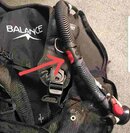EireDiver606
Contributor
The reason I didn’t want to link anything is because the problem with them more-so than the design, I think is that it creates a less ideal form of gas sharing. It’s not as much as the quality of gas flow through the reg.
Welcome to ScubaBoard, the world's largest scuba diving community. Registration is not required to read the forums, but we encourage you to join. Joining has its benefits and enables you to participate in the discussions.
Benefits of registering include
PADI does not dictate any specific method for air shares. Instructors are free to teach whatever method they wish, provided, of course, that it works.What is PADIs take on a divers trim while in a gas sharing episode?
Why don’t rec divers dive as safely as tech divers while still rec diving? Gas sharing with a long hose and bungees back up is much easier than 2 short hoses.
This is a genuine question. I think it’s just a mindset but if anyone has good info, I’d be happy to hear
What is PADIs take on a divers trim while in a gas sharing episode?
It's a pretty easy answer. The gear and procedures that tech divers use are more expensive, and require extra effort to use. I'm summing up extra training, drills, etc there as extra effort. The procedures used by rec divers works with pretty much any gear except tech gear (depending on what exactly that is). It's easy to learn as pretty much all new divers learn it in the short open water course, and much of it is so simple that it can be successfully performed without regular drills to keep you fresh.Why don’t rec divers dive as safely as tech divers while still rec diving? Gas sharing with a long hose and bungees back up is much easier than 2 short hoses.
This is a genuine question. I think it’s just a mindset but if anyone has good info, I’d be happy to hear
Is this a joke?PADI requires a divers trim to be optimum and in good form, even in a life saving emergency. There's never an excuse for bad trim, especially when you're trying to conserve gas, and should the ascending buddy team be photographed, they want to set a good example.
.
If they ascend with an Air 2 in their mouths, it is because they are sharing air with someone else during an OOA emergency.
No, it does not happen often, but when it does, you do need to be able to vent air from the BCD as you ascend, or else you and the buddy you are supposedly rescuing will have an uncontrolled ascent to add to your problems.
I can see where in that scenario it would be more convenient to have a pull dump but I do wonder how many divers consciously make the decision to get a BCD with a functioning pull dump, use it regularly and would think to use it under those conditions.
ThanksPADI does not dictate any specific method for air shares. Instructors are free to teach whatever method they wish, provided, of course, that it works.
When I taught OW classes, my feeling was that 90% of my students were going to rent gear for their first dives. In the classroom, I talked about all the different options they could use and described the pros and cons. I showed what I used (long hose and bungeed alternate) and explained why. In the pool and OW, we used what the shop provided, which is the standard rental kit they would find almost anywhere they went to dive.
If we are just talking about the regulator hose setup, this is absolutely not true. The only difference is the length of the hoses and where they go. I would argue that handing someone your primary regulator and pulling the alternate that is around the neck up to your mouth is easier than using the traditional octo setup.The gear and procedures that tech divers use are more expensive, and require extra effort to use. I'm summing up extra training, drills, etc there as extra effort.
Despite what you read on ScubaBoard, going OOA is pretty rare. I have been in the vicinity of an OOA situation exactly once in my life, and I have done a lot of dives in a lot of places.I think if that weren't true, you'd see rec divers drowning in droves. Running OOA seems to be somewhat common just based on the occasional post where it happened to someone or a poster saw it happen to another person
The reason this works for @caruso is this connection here:I can confirm that on my SeaQuest Balance BCD I can simply pull on any part of the corrugated (2 part) hose (not on the regulator), which will then expand and pull on the internal cable and this procedure will allow gas to escape from the shoulder vent.

